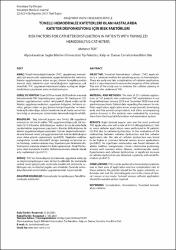| dc.contributor.author | Tort, Mehmet | |
| dc.date.accessioned | 2022-07-04T12:49:28Z | |
| dc.date.available | 2022-07-04T12:49:28Z | |
| dc.date.issued | 2021 | en_US |
| dc.identifier.citation | Mehmet, T. O. R. T. (2021). TÜNELLİ HEMODİYALİZ KATETERLERİ OLAN HASTALARDA KATETER DİSFONKSİYONU İÇİN RİSK FAKTÖRLERİ. Kocatepe Tıp Dergisi, 22(5), 422-428. | en_US |
| dc.identifier.issn | 2149-7869 | |
| dc.identifier.uri | https://doi.org/10.18229/kocatepetip.901858 | |
| dc.identifier.uri | https://hdl.handle.net/20.500.12933/1313 | |
| dc.description.abstract | AMAÇ: Tünelli hemodiyaliz kateter (THC) uygulaması, hemodiyaliz için erişim yolu sağlamada yaygın kullanılan bir metottur.
Kateter uygulamasının erken ve geç dönem komplikasyonları
mevcut olup, kateterin uzun ömürlülüğünün sağlanması çok
önemlidir. THC uygulanan hastalarda kateter açıklığının değerlendirilmesi çalışmanın amacını oluşturmuştur.
GEREÇ VE YÖNTEM: Ocak 2019 ve Aralık 2020 tarihleri arasında
hastanemizde THC implantasyonu yapılan 181 hastaya ait 221
kateter uygulamasının verileri retrospektif olarak analiz edildi.
Kateter uygulama nedenleri, uygulama bölgeleri, kullanım süreleri, gelişen erken ve geç dönem komplikasyonları ve hastalarda eşlik eden diğer sistem hastalıklarına ait hasta verileri hastane bilgi ve otomasyon sisteminden taranarak değerlendirildi.
BULGULAR: Sağ internal juguler ven %44,3 (98 uygulama)
oranıyla en sık tercih edilen THC uygulama bölgesiydi. 28 hastada (%15.5) kateter disfonksiyonu nedenli bir ya da daha fazla
sayıda kateter uygulaması yapılmıştır. Kateter disfonksiyonu ile
kateter uygulama bölgesi arasındaki ilişkinin değerlendirmesinde ana femoral venöz yol uygulamalarında kateter disfonksiyon
oranı daha yüksek saptanmıştır (p=0.002). Diyabetes mellitus
maligniteler, kronik obstrüktif akciğer hastalığı ve koroner arter hastalığı, serebrovaskuler olay, hipertansiyon ile kateter disfonksiyonu arasında anlamlı bir ilişki saptanmadı. Atrial fibrilasyonu olan hastalarda kateter disfonksiyonunda anlamlı olarak
artış saptanmıştır (p=0.017).
SONUÇ: THC’leri hemodiyaliz hastalarında uygulama kolaylığı
ve düşük komplikasyon oranı ile tercih edilebilir. Bu hastalarda
santral venöz girişim yolu seçiminde öncelik üst ekstremite subklavyen ven ve internal juguler ven olmalıdır. Zorunda kalmadıkça femoral venöz kateter uygulamasından kaçınılmalıdır. | en_US |
| dc.description.abstract | OBJECTIVE: Tunneled hemodialysis catheter (THC) application is a common method for providing access to hemodialysis.
There are early and late complications of catheter application,
and it is very important to ensure the longevity of the catheter.
The aim of the study was to evaluate the catheter patency in
patients who underwent THC.
MATERIAL AND METHODS: The data of 221 catheter applications of 181 patients who underwent THC implantation in our
hospital between January 2019 and December 2020 were analyzed retrospectively. Patient data regarding the reasons for catheter application, application areas, usage periods, developing
early and late period complications and other accompanying
system diseases in the patients were evaluated by scanning
them from the hospital information and automation system.
RESULTS: Right internal jugular vein was the most preferred
THC application site with a rate of 44.3% (98 applications). One
or more catheter applications were performed in 28 patients
(15.5%) due to catheter dysfunction. In the evaluation of the
relationship between catheter dysfunction and the catheter
application site, the rate of catheter dysfunction was found
to be higher in common femoral venous access applications
(p=0.002). No significant relationship was found between diabetes mellitus, malignancies, chronic obstructive pulmonary
disease and coronary artery disease, cerebrovascular event,
hypertension and catheter dysfunction. A significant increase
in catheter dysfunction was detected in patients with atrial fibrillation (p=0.017).
CONCLUSIONS: THCs can be preferred in hemodialysis patients
due to their ease of application and low complication rate. In
these patients, the priority should be the upper extremity subclavian vein and the internal jugular vein in the choise of central venous access route. Femoral venous catheter application
should be avoided unless required. | en_US |
| dc.language.iso | tur | en_US |
| dc.publisher | Afyonkarahisar Sağlık Bilimleri Üniversitesi | en_US |
| dc.relation.isversionof | 10.18229/kocatepetip.901858 | en_US |
| dc.rights | info:eu-repo/semantics/openAccess | en_US |
| dc.subject | Hemodiyaliz | en_US |
| dc.subject | Komplikasyon | en_US |
| dc.subject | Tünelli hemodiyaliz kateterler | en_US |
| dc.subject | Complication | en_US |
| dc.subject | Hemodialysis | en_US |
| dc.subject | Tunneled hemodialysis catheter | en_US |
| dc.title | TÜNELLİ HEMODİYALİZ KATETERLERİ OLAN HASTALARDA KATETER DİSFONKSİYONU İÇİN RİSK FAKTÖRLERİ | en_US |
| dc.title.alternative | RISK FACTORS FOR CATHETER DYSFUNCTION IN PATIENTS WITH TUNNELED HEMODIALYSIS CATHETERS | en_US |
| dc.type | article | en_US |
| dc.authorid | 0000-0001-8414-3751 | en_US |
| dc.department | AFSÜ, Tıp Fakültesi, Cerrahi Tıp Bilimleri Bölümü, Kalp ve Damar Cerrahisi Ana Bilim Dalı | en_US |
| dc.contributor.institutionauthor | Tort, Mehmet | |
| dc.identifier.volume | 22 | en_US |
| dc.identifier.issue | 5 | en_US |
| dc.identifier.startpage | 422 | en_US |
| dc.identifier.endpage | 428 | en_US |
| dc.relation.journal | Kocatepe Tıp Dergisi | en_US |
| dc.relation.publicationcategory | Makale - Ulusal Hakemli Dergi - Kurum Öğretim Elemanı | en_US |
















